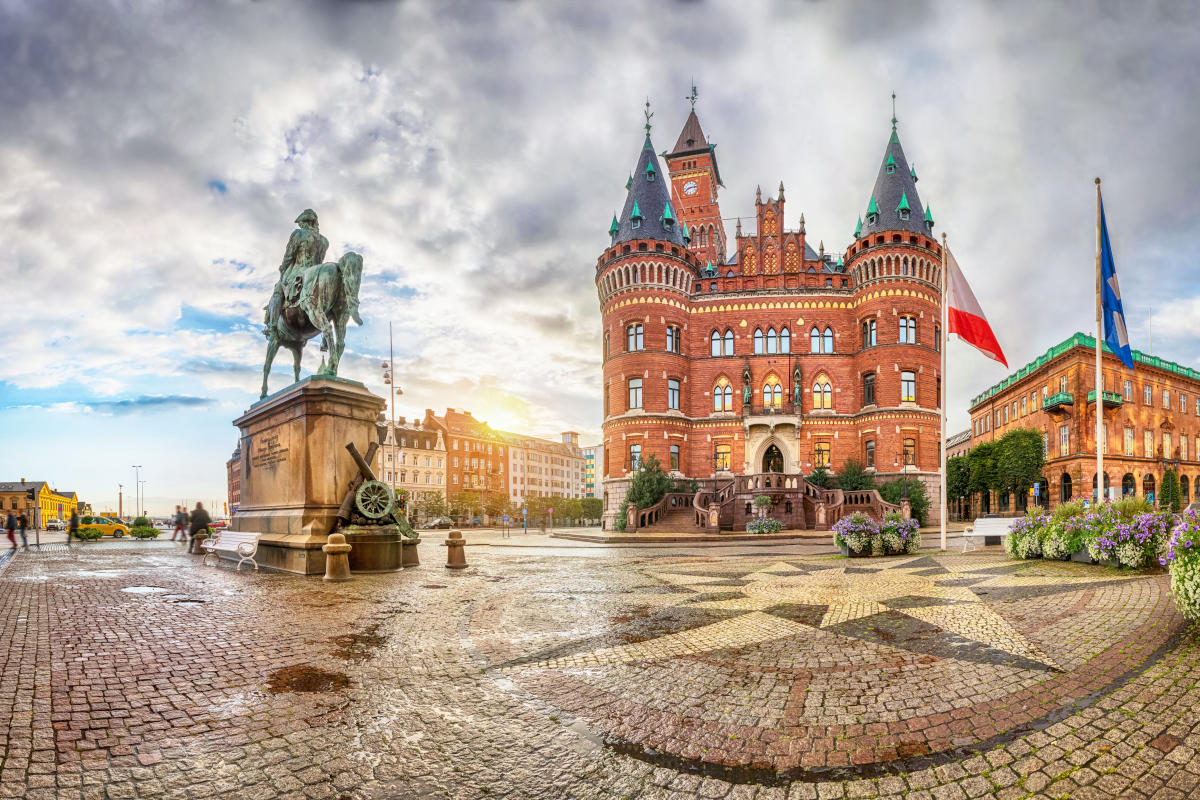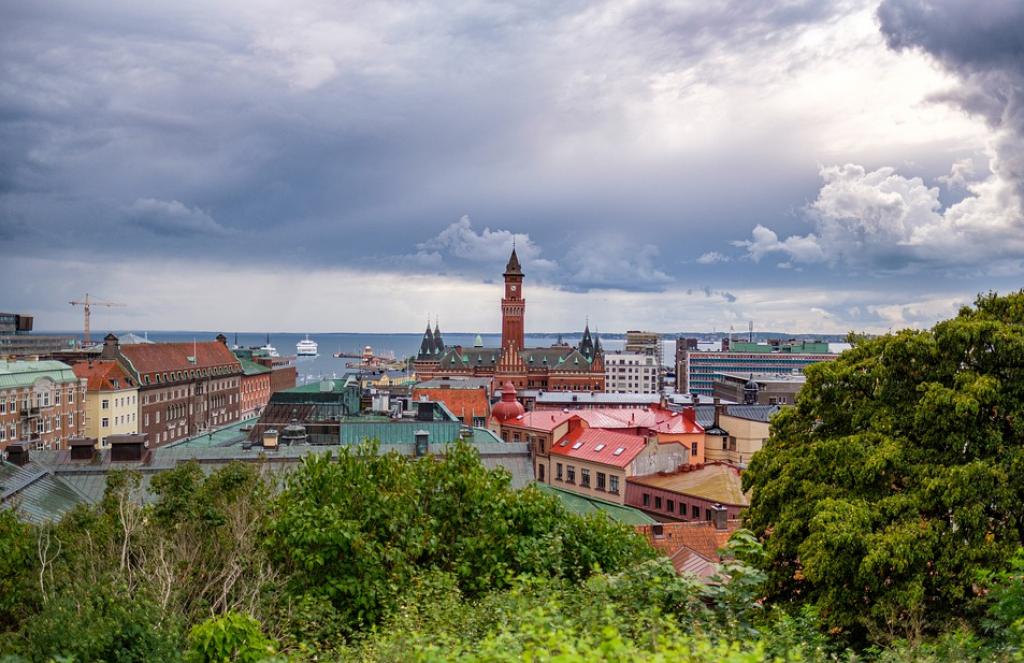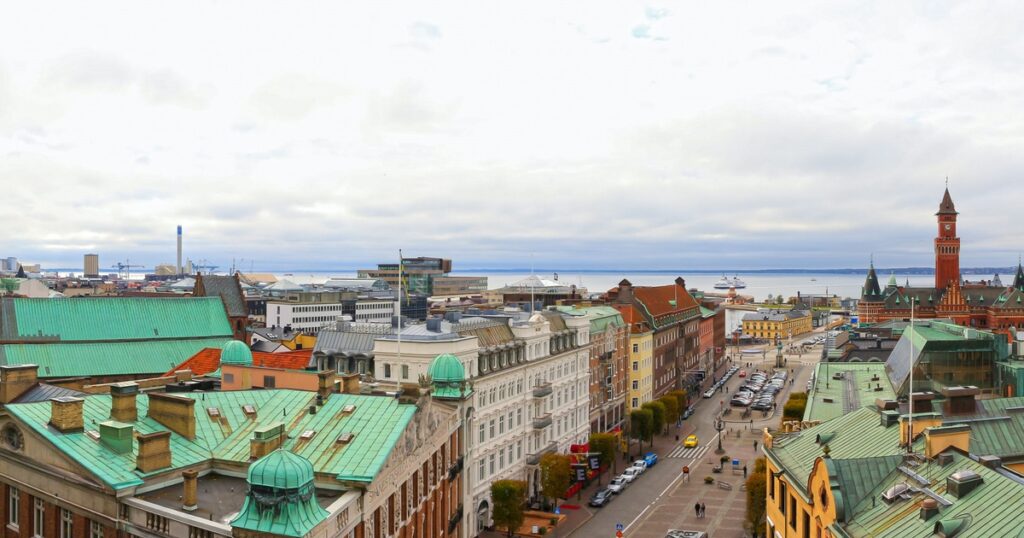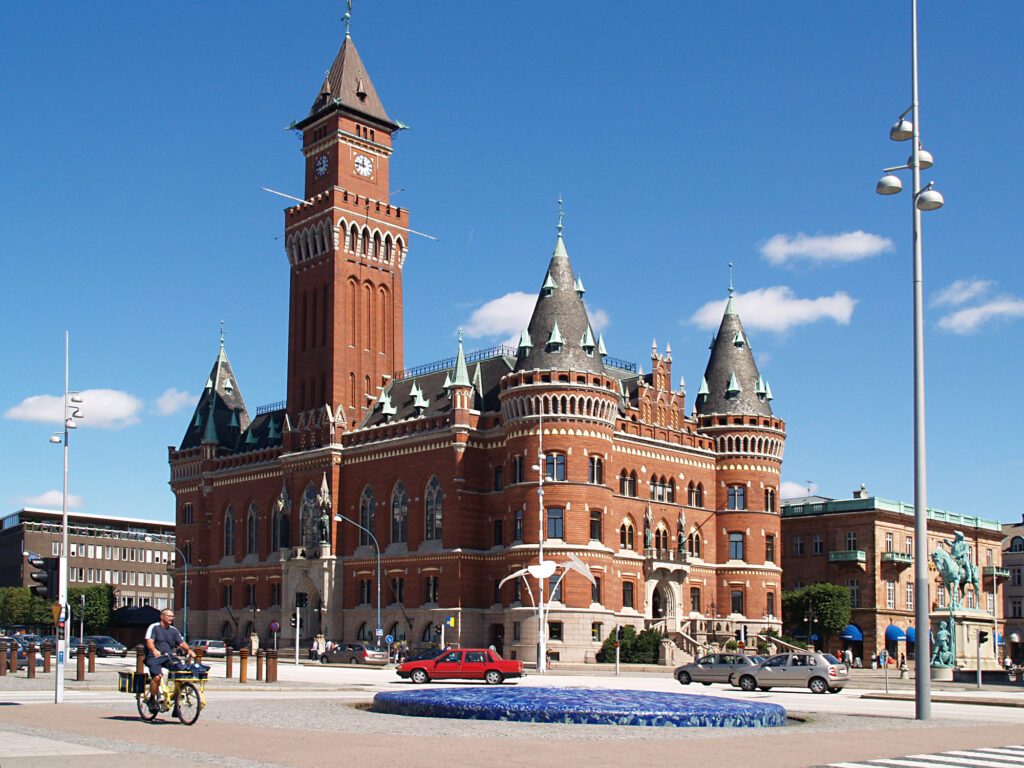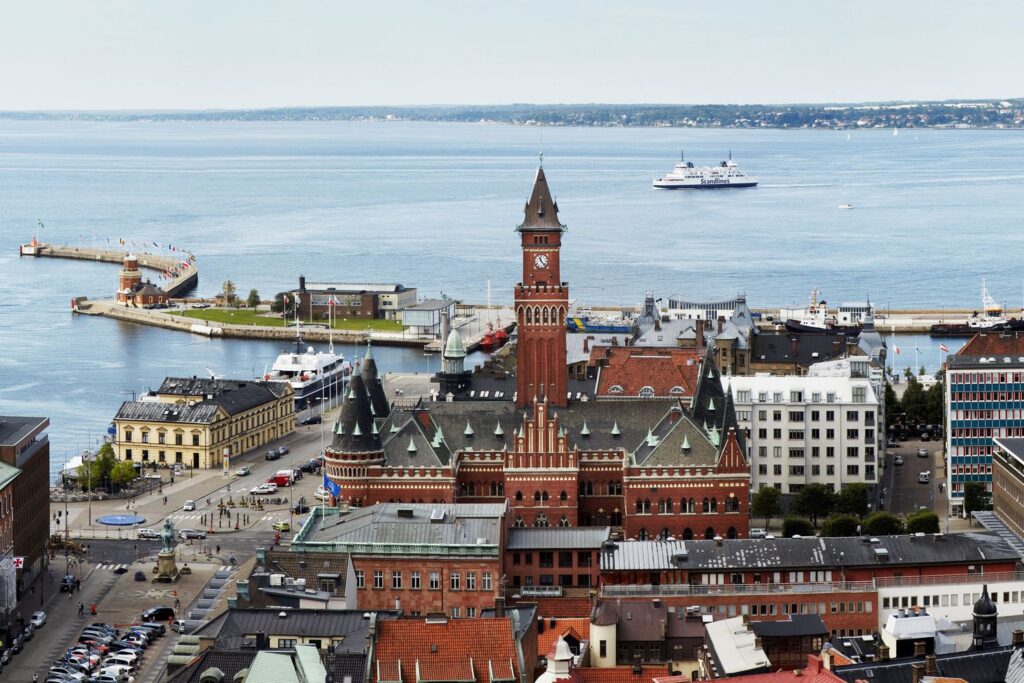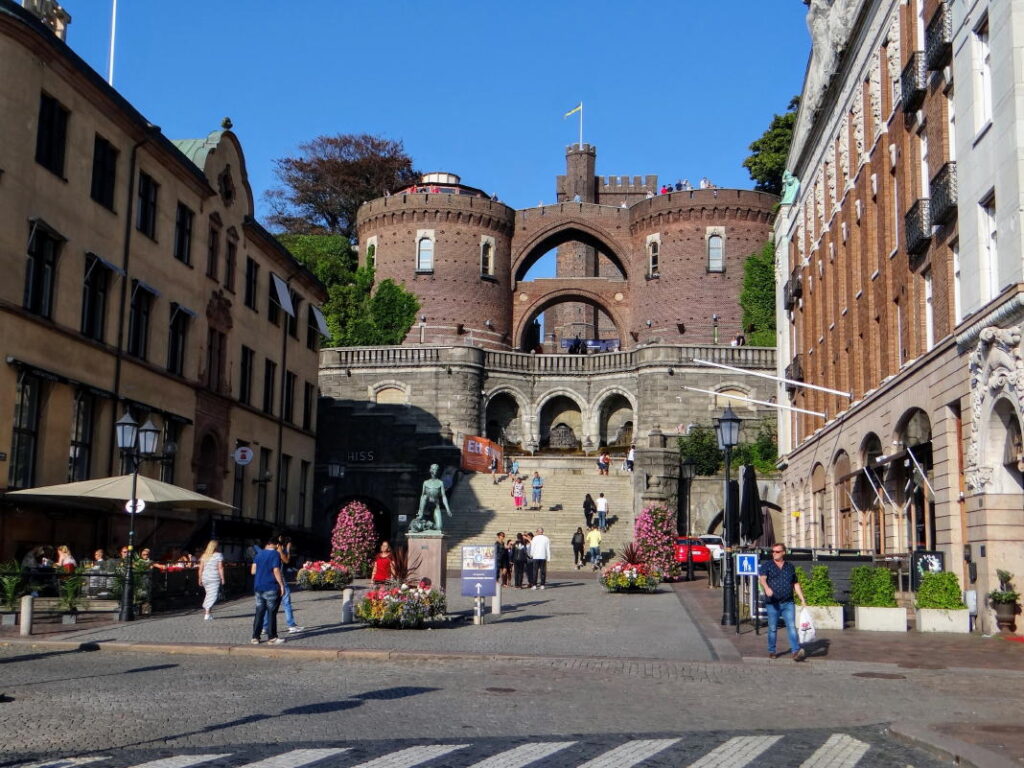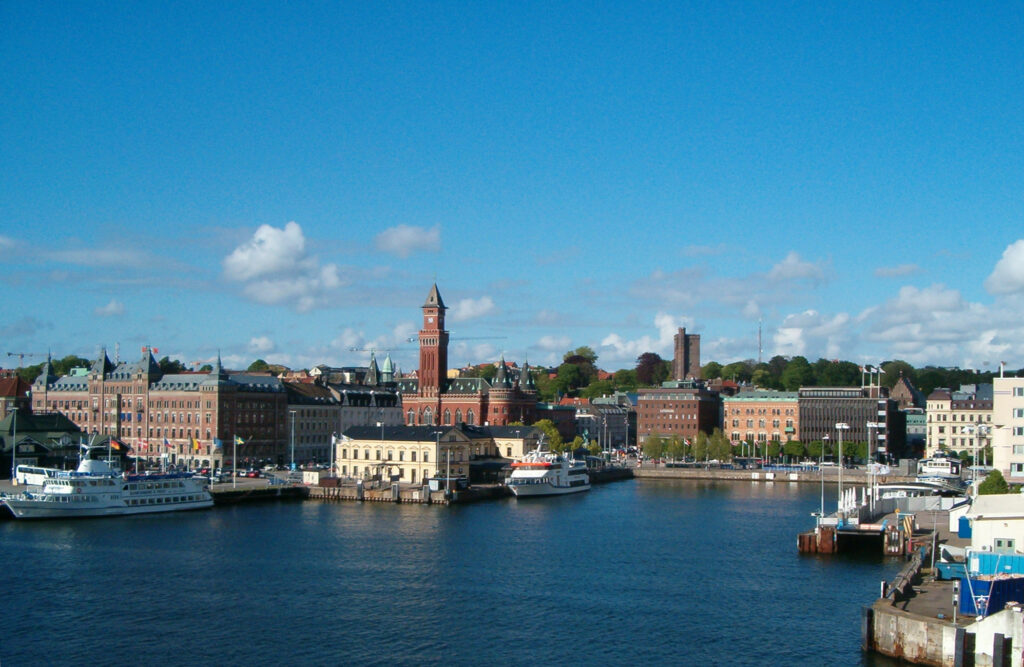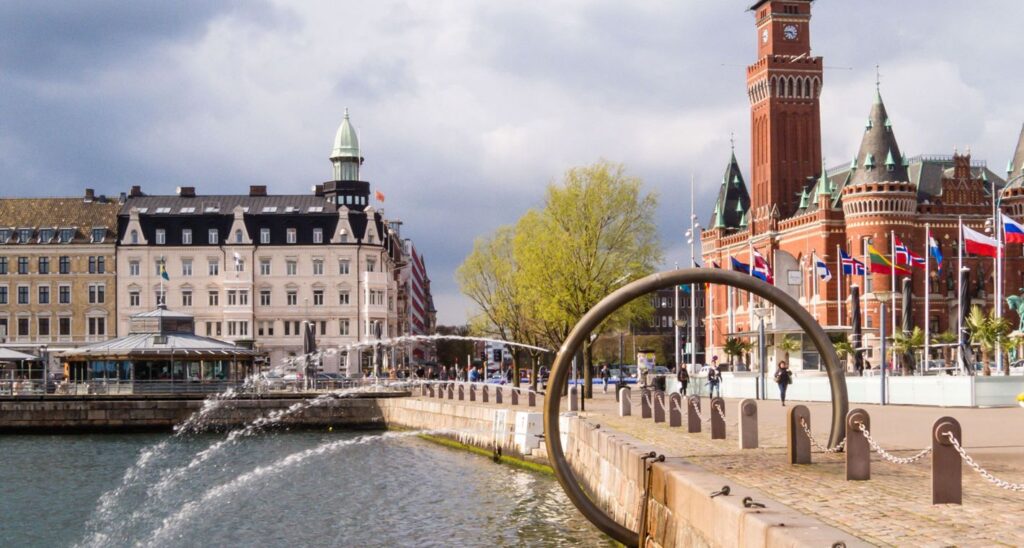Helsingborg is a town and the seat of Helsingborg Municipality, Scania, Sweden. It had 112,496 inhabitants in 2019. Helsingborg is the centre of the northern part of western Scania and Sweden’s closest point to Denmark: the Danish city Helsingør is clearly visible about 4 km (2 mi) to the west on the other side of the Øresund. The HH Ferry route across the sound has more than 70 car ferry departures from each harbour every day.
Attractions
Central parts
- Dunkers culture house
- Gamlegård
- Gustav Adolf’s church
- Helsingborg Sports Museum
- Helsingborg Concert Hall
- Helsingborg City Hall
- Helsingborg City Theater
- Henckelska farm
- Jacob Hansen’s house
- The core
- Norra Hamnen
- St. Mary’s Church
- Stortorget
- The terrace stairs
Eastern parts
- Fredriksdals open-air museum
- Helsingborg Arena
- Helsingborg Tropicarium
- House of Sports
- Olympia
- Technology in grandfather’s time
Southern parts
- Frameless health well
- Raw fishing village
- Råå Museum
- Råå vallar
Northern parts
- The Emergency Museum
- Pålsjö cemetery
- Pålsjö forest
- Pålsjö castle
- Sofiero
Squares and places
The most dominant square in Helsingborg is Stortorget , which extends from Terrasstrapporna and Konsul Trapp’s place to the east and slopes easily down to the transition between Drottninggatan and Järnvägsgatan to the west. The square has acquired its peculiar elongated character from the fact that it was added during the Danish occupation of the city in the 1670s when the Danish army drew a wide supply line between Helsingborg Castle and the harbor, straight through existing buildings.
In Stortorget’s extension towards the harbor is Hamntorget, which was added in the 1890s with the construction of the North Harbor . At the square are the old customs house , which has long been a terminal for passenger ferries across the strait, and the Steam Ferry Station. Farthest to the east, just by the pier, Carl Mille’s statue of the Maritime Goddess sits on a high pedestal and next to this is a monument to Charles XIV Johan’s landing in Helsingborg. From Hamntorget and away towards Knutpunkten is Kungstorgetwhich, having been mostly parking and track area during the time when there were railway tracks straight through the city, is now transformed into a place with outdoor cafes and stage for various events.
Sundstorget was built in 1865 on backfill land in the Sound. Several monumental buildings were built around the square, mainly from around the turn of the century 1900. Due to the construction of a market hall in the western part of the square, most of the market trade was moved from Stortorget to Sundstorget. During the latter part of the 20th century, however, the market hall was demolished and the square instead became a parking square, almost as if on a small area where Sundstorget’s grill was located. In 2004, the square was rebuilt and the car park was located in an underground parking garage on two floors and a glass market hall was built, this time on the south side of the square. Along the square’s northern façade are several restaurants and to the west the square is enclosed by Dunkers Kulturhus.
Several places in Helsingborg have been named by people of great importance to the city. Some examples are Henry Dunker’s place between the concert hall and the city theater , which got its name at the H99 exhibition to honor Henry Dunker’s contribution to the city’s cultural life through the Dunker foundations . Consul Olsson’s site is centrally located, nestled in the middle of Kullagatan near Consul Petter Olsson’s warehouse building. At the Terrace Stairs, Consul Oscar Trapp has been honored with his ownplace as a thank you for his drive in the restoration of the Core, the construction of the Terrace Stairs and the preservation of several older buildings. At the place where the old, now demolished, theater was located on Bruksgatan , director Ingmar Bergman was honored with a place in 2008; Bergman was theater director at Helsingborg City Theater 1944–1946.
Parks and green areas
Several of Helsingborg’s parks lie like a wreath around the city’s central parts, where the very first parks were created in the late 19th century. The densification of the city and the many new industries made the need for green areas for relaxation and recreation increasingly apparent. Many of the city’s parks have previously been gardens donated to the city by its wealthy owners.
The first real park that was laid out was the Krookska plantation located between Helsingborg’s then inner city and the new district Söder. On the site was previously the Bollbro accident, which was part of the city’s field land. There were plans to build on the land to connect the districts, but instead the siblings Krook bought it up and donated it to the city to be used for planting. The park was laid out in 1873–1874 and opened to the public in 1877 .
Another early park in Helsingborg is Öresundsparken, which is located in a ravine in the country castle called Hälsobacken, but also with some up on the country castle. The park was laid out in 1876–1877 after the operations in the watermills that formed Helsingborg’s earliest industrial area moved to the new industrial area in Söder. The slopes of the park are richly overgrown with rhododendron bushes and shady trees. Here is also the Sofia spring, which was found in 1889 and which is Sweden’s only natural salt water spring. The area around Kärnan has housed very sparse buildings ever since Charles XI ordered that the entire castle, except Kärnan, be demolished. In connection with the Helsingborg Exhibition 1903 around Kärnan, a park called was createdThe castle garden and a playground have been in the park since 1906.
Some of Helsingborg’s most famous parks have been added through donations from some of the city’s prominent residents. To the east of the sports area at Olympia is Fredriksdal’s open-air museum , which was donated to the city of Helsingborg in 1918 by Consul Trapp’s widow, Gisela Trapp. The park houses Fredriksdal’s manor , botanical garden, orchard and Fredriksdalsteatern . After Gustaf VI Adolf’s death, the city of Helsingborg received Sofiero Castle with an associated garden as a gift. The park has become famous for its many different species of rhododendron and various events, such as the Sofiero Trophy orchid competition and the Sofiero Classic veteran car exhibition. Another donation is Vikingsberg with its park, located on the castle, which Ida and Otto Banck handed over to the city in 1912. The villa itself on Vikingsberg housed the city’s art collection for a long time and is currently a private art gallery. The park consists of both bush-framed gardens, water lily pond and open green areas.
With the creation of the Landborg promenade , several of the city’s parks have been tied together, from Pålsjö forest to Råådalen through a hiking trail on the edge of the landborg.
Beaches
Helsingborg has several beaches within walking distance of the center. One of these is Tropical Beach at Parapeten , created in connection with the H99 exhibition, with placed palm trees, rafters and sun loungers. Further north, along the Strandpromenaden, are Järnvägsmännens bad and Gröningen . There is a large green area to sunbathe on and a large wooden deck with associated jetties. Further north along the promenade is one of Helsingborg’s most popular beaches, Örestrandsbadet , or Fria Bad as it is popularly called. The city’s northernmost beaches areVikingstrand , well adapted for the disabled, and Tinkarpsbadet, which is one of the calmer beaches in Helsingborg.
South of Helsingborg, the Sound is very shallow. Here are the beaches Råå vallar and Örby meadows . North of these, near the harbor area, is Helsingborg’s only naturist beach : Knähakenbadet . There are also three cold bath houses in the city. Two of them in the north, Pålsjöbaden (just south of Vikingstrand) and Norra kallbadhuset (or Kallis as it is popularly called), between Gröningen and Fria Bad. To the south is Råå cold bath house at Rååbadet next to the marina.
Museums
The history-interested consul Oscar Trapp proposed in the early 1900s that a museum be established in Helsingborg and in 1909 the new city museum opened, housed in the old school building on Södra Storgatan, with collections that began to be collected as early as the 1890s. The original collection consisted of both scientific, archaeological, ethnographic and cultural historical objects as well as works of art. When Otto Banck donated Vikingsberg to the city of Helsingborg in 1912, the art collections could be housed there, which was moved there in 1929. In 1918, Oscar Trapp’s widow Gisela Trapp donated Fredriksdal with associated land to the museum, with the intention that it would be used as an open-air museum and that the land would also finance the museum’s activities. Over time, the City Museum’s premises on Södra Storgatan became too small, but it was not until 2002 that this problem was solved when both the cultural andcity historycollections on Södra Storgatan and the art collection on Vikingsberg were moved to the newly builtDunkers kulturhus.Dunkers kulturhus south facade, seen from Helsingörskajen.
Over time, Fredriksdal’s open-air museum has been expanded with historic farms from various places in Scania and culturally and historically interesting buildings from Helsingborg’s older urban areas. The museum also has an orchard, botanical garden and open-air theater. In one of the houses from old Helsingborg is the Graphic Museum, which is the Nordic region’s largest printing museum, and shows the history of printing art from Johannes Gutenberg to our time. Kulturmagasinet is connected to Fredriksdal, where large parts of the very extensive collections from Helsingborg’s museums are stored. Kulturmagasinet is also responsible for Kärnan’s maintenance, in its capacity as owner, as well as cultural environmental care and conservation.
At Bergaliden, east of Kärnan, are two more museums. One is the School Museum , which was inaugurated in 1985 , located in the old Östra school next to Slottsvångsskolan. The school museum shows restored school environments and objects that have been used at various primary schools in Helsingborg municipality over the years. The second is the Museum of Medical History , housed in the former children’s hospital, which in turn shows environments and objects from care. Helsingborg Sports Museum is located in the newly renovated former IOGT building, on Carl Krooks gata in Söder.which exhibits objects from the city’s sports history and arranges various events, lectures and nominates Athlete of the Year in Helsingborg.
Outside the city is the privately owned Emergency Preparedness Museum , Sweden’s only museum in an underground defense facility from World War II: Battery Helsingborg. The Emergency Preparedness Museum is nationally known, above all through the dispute over the image A Swedish tiger .
Shopping
Through the conversion of Kullagatan to Kulla pedestrian street in 1961, Helsingborg got one of Sweden’s first pedestrian streets. The idea came from the street Lijnbaan in Rotterdam , but differs from this in that it goes through older buildings instead of a newly built urban environment. At first, the traders were hesitant about the idea, but when it quickly turned out to be a success, most were convinced. The shopping street continues south in the form of Mariagatan and Bruksgatan’s pedestrian streets. Also along the Norra and Södra Storgatorna, which in the east run parallel to Kullagatan and Bruksgatan, respectively, there are several shops of various kinds, even if these are not pedestrian streets.
As a continuation of the shopping lane after Stadsparken, Södergatan runs out to Söder. Södergatan is not a pedestrian street either, but the city of Helsingborg has widened the street’s sidewalks to make the street more attractive to the shops’ customers. At Mäster Palm’s site along Södergatan is the mall Söderpunkten, which was previously an EPA department store . The mall contains several shops and some eateries.
Recurring cultural events
- Love & Light (February) – light festival with a love theme for a week around Valentine’s Day. Successor to previous Midwinter lights.
- Easter party at Fredriksdal (March / April) – various events for children during Easter.
- Sofiero Classic (May) – exhibition at Sofiero with vintage vehicles.
- Sofiero Trophy (June) – orchid competition with associated exhibition and sale of orchids.
- Rose days at Fredriksdal (July) – tips and advice on roses are given with guided rose walks on various themes.
- Antikmässan (July) – an antique fair held at Idrottens hus .
- Fun-in-July (July) – outdoor revue played since 1968 in Slottshagen.
- Hx (August) – summer event that lasts for three days all over the city with music, culture and sports. Successor to the previous Helsingborg Festival .
- The big garden party (August) – garden exhibition at Sofiero.
- Helsingborgs boat fair (August) – exhibition focused on small boats and which ends with a crayfish party.
- Christmas signage (December) – the city’s shops show off their shop windows before Christmas.
- Christmas atmosphere at Sofiero (December) – sale of Christmas decorations and food and inspiration for conservatories before Christmas.
